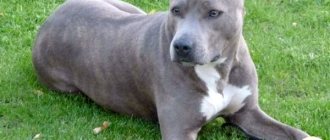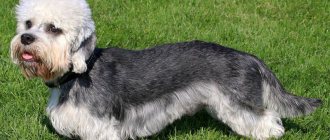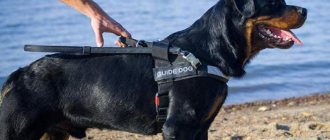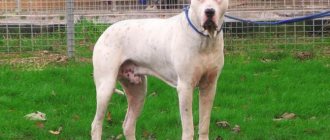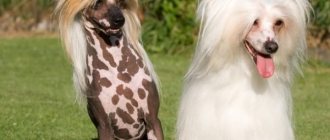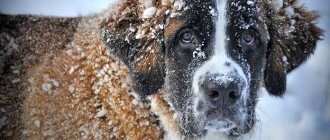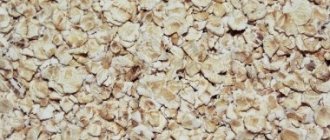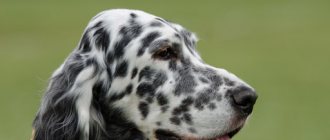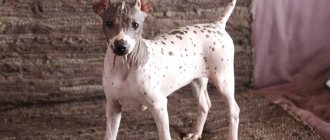Ratcatcher dogs - 90 photos of the main breeds, features of training and training of ratcatchers
The breed of rat catcher dog has been known since ancient times. People have long noticed the commitment of some varieties of these pets to hunting rats and mice. No worse than cats. But over time, their qualities faded due to lack of practice.
However, there are now special breeds, and the best rat-catching dogs have huge success at shows and in breeders' clubs.
Natural talent
An interest in rodents was noticed in a number of terriers, but some breeders themselves developed the necessary instincts. Thus, during the selection process, a number of rat-catching breeds were developed.
For example, the Andalusian tavern is a “product” of crossing different types of terriers that have the desire to catch not only rats, but also mice.
As a result, people got several types of rat catchers at once. Light-colored specimens were intended for catching rodents on ships, in barns and other dark rooms, while black and spotted ones were intended for catching rodents in the open spaces of villas and private lands.
In this way, not only transported cargo and supplies in barns were saved, but also crops and crops in the fields.
Mouse-catching and rat-catching dogs became no less popular than “noble” cats, who caught rats and mice regularly and partly thanks to instincts.
Interesting stories
There were stories dating back to the beginning of the 19th century, the heroes of which were the most ordinary mongrels. Dozens of caught rodents were credited to them.
At one time there was even a sweepstakes where bets were placed on the most agile rat-catching dogs. So, Billy the terrier caught and killed over a hundred rats in just 10 minutes. This took place in England, at one of the London sweepstakes.
In the history of these breeds, there were rescues of granaries and rural farmsteads of chickens and other poultry. Terrier Jacko 15th was able to destroy a dozen rats in just over 5 minutes.
Another precedent: in a barn, a small dog killed more than 2 thousand rodents. It was a fox terrier. He was merciless to both rats and mice. The dog with absolutely smooth, shiny fur amazed with its beauty and agility.
Varieties of rats
People have long noted the ability of all types of terriers to exterminate rodents. In particular, these are breeds of small long-haired rat-catcher dogs: Manchester Terrier, Andalusian Inn Pied Piper, Smooth Fox Terrier, etc.
Breeders consider the Rat Terrier to be a particularly smart and dexterous mouse fighter. Photos of rat-catching dogs can be admired below. It was the most notorious ones who introduced the rats. They are the ones that are popular in their segment.
Don't think that if there are no mice or rats nearby, these dogs will sit idle. They are terrible at snoring. According to some, as soon as they hear any glanders, they immediately bite you on the heels.
Terriers
There is an opinion that cats hunt when they are hungry, and dogs hunt out of excitement and idle interest. This is wrong.
Experts confirm that a cat will never allow the presence of rodents on its territory, even if it is very well fed. Just like a terrier, be it a Scotch or an Airedale.
Terriers have very high energy levels. They are just looking for where to put their energy. Terriers are excellent burrowers, sneaky and nimble. Why do these dogs have rather thick tails? For him, the owner easily pulled the dog, along with the trophy, out of the hole.
You can even keep this dog in an apartment, but where can you buy a rat-catcher dog? It is worth contacting the breeders club. They will offer you the most profitable option.
Puppies are not that expensive. Especially now, when hunting rodents is not very popular, like, for example, 50-100 years ago.
Such dogs are used to catch mice at dachas, in private farmsteads in the south of the country, in cottage villages, when in the summer it is necessary to rid the garden of mole crickets and the crops of voles.
Interesting facts about the Yorkshire Terrier breed
1. The small Yorkshire terrier is a real hunter. This breed was bred in the province of Yorkshire. Small dogs were kept by simple peasants, whom the fearless terrier helped fight rats.
2. A small but very smart dog. The opinion that small dogs do not shine with intelligence is easy to refute; you just need to have this miracle at home. The puppy learns commands very quickly: sit, lie down, give a paw - they unlearn them literally in one day.
3. Yorkshire Terrier knows how to smile! Of course, not entirely consciously, but the dog gradually begins to imitate the leader of the pack, that is, his beloved owner. And if you constantly smile at your beloved furry, he will soon begin to smile back. And thanks to the specific structure of their muzzle, Yorkies are considered the most smiling.
4.This breed can be kept by people suffering from allergies. The fact is that the Yorkshire Terrier's coat is similar in structure to human hair, and in addition, Yorkies do not shed. The disadvantages include the lack of undercoat - in cold weather the baby will freeze. A huge range of clothing for dogs will help solve this problem: T-shirts, bikers, overalls, dresses for any weather.
5.The character of the dog, the size of the cat. A purebred Yorkshire Terrier weighs up to 4 kg. The standard weight of a dog is 3-3.5 kg; dogs of less weight are classified as mini.
6.Sociable and courageous. Yorkshire terriers, despite their small size, are true protectors. There are known cases when during the war a dog named Smokey helped soldiers lay communications, and a year ago in New Jersey, a Yorkie drove a bear out of his owner’s house.
7.Luxurious wool. With proper care, the coat looks perfect, grows quickly and is easy to comb. And if it is never cut, the length of the coat can be several times greater than the length of the dog’s body. To make the fur shiny, use preparations with mink oil.
8.Active and cheerful. The Yorkie, like all terriers, is a very active dog. At birth, Yorkie puppies sleep up to 80-90% of the time, but as they grow up they become real liveliest. This breed is worth recommending to people who are willing to spend a lot of time playing with their pet: chase, fetch, take the ball, guess which hand it’s in... the games are very varied and fun.
9.In the toilet on the tray. If you set a goal, it’s not at all difficult to teach your baby to relieve himself in a litter box (a dog litter box differs from a cat litter box in having lower sides) or in a diaper. You can purchase reusable absorbent diapers, disposable dog diapers at a pet store, or inexpensive disposable diapers from a regular pharmacy.
10. It’s impossible not to fall in love with a Yorkie. Even the most inveterate lovers of small dogs, after spending some time with this baby, begin to be touched and amazed at his intelligence.
Manchester Terrier
One of the most popular breeds that has been fighting rodents for centuries. It was bred over 500 years ago. To this day, these dogs save people from infestations of rats and mice.
The Manchester Terrier is obedient, friendly, loves everyone in the household and is very playful. Training a puppy lasts about a couple of months, but then throughout its life the pet pleases its owners with its gentle disposition, resourcefulness and dexterity.
A muscular terrier with a high degree of endurance, he is quite calm and observant. He plays with the kids all day long. At the same time, it will not bite or hurt even the smallest.
Cairn Terrier
Cairn Terriers are considered the progenitors of all Scottish Terriers. Back in the 16th century, they actively participated in hunting badgers and foxes.
Initially, the name of the breed sounded like “pointy-eared Skye terrier.” It was on the Isle of Skye that these animals were used by local residents to hunt small game and rodents.
Only in the 20th century, the shaggy dog, whose weight does not exceed 6-9 kg, was renamed the Cairn Terrier to indicate that it copes well with catching predators in mountainous areas.
For many years, representatives of the breed have been faithful companions of British and Scottish farmers, helping them in the mass extermination of rodents. Today, these dogs are bred exclusively as companions.
Brief historical background
Rats are sources of infection, dangerous diseases, and destroyers of supplies and seed. They could get into poultry houses and destroy not only chickens, but also adult chickens. The damage caused by rats has always been significant. That is why the rat-catcher dog has become simply necessary.
The Prague Doggie Ratlik, or rat dog, is the only breed for which catching rats is the main activity
The hunting instincts of dogs were used to breed the corresponding breeds, which is why among the rodent destroyers there are so many terriers - born hunters. The first success in selection dates back to the 19th century. A terrier appeared in England that could kill in 5 minutes. several rats.
History of the origin of the species
The reliable history of the appearance of the Prague rat is unknown. The breed is shrouded in a lot of legends, which one to believe is up to everyone to decide for themselves. The first descriptions of a similar dog date back to the 7th century.
The Great Inquisition brought the greatest popularity to little rat catchers. Cats were considered evil spirits, assistants to witches and servants of the devil, and sanitary conditions left much to be desired - ideal conditions for the breeding of rats. Rodents, carriers of plague, posed a real threat not only to crops, but also to people. It was small dogs that helped get rid of the hordes of rats that attacked medieval Europe.
Rats were given to the monarchs of Germany, France, and England as a sign of deep respect. Prince Borislav the Smely was known as the greatest connoisseur of the breed, and it was thanks to him that the rat dog found its way into the highest houses of Western Europe.
The Soviet occupation of the Czech Republic led to the death of the breed's livestock , the disbandment of nurseries, and the loss of stud books. Breeders and breed lovers had to revive the Ratliks bit by bit. Only towards the end of the 19th century did the number of individuals cease to be critical. But until now, the Liben chamois remains a rare breed.
Ratlik is still recognized by the International Cynological Federation. But the breed was included in the lists of other, no less authoritative cynological organizations, including the RKF.
Distinctive features of the group
Dogs catch rats much better than cats, which simply cannot cope with a powerful and brave rodent that does not give up without a fight. The corresponding breeds of dogs are driven to victory by passion and an innate hunting instinct. They perceive the rat as prey that needs to be caught and destroyed. That is why various terriers, without a shadow of fear or doubt, rush into holes in which rodents live.
Note! Most often, rat catchers are small in size, they are very dynamic and nimble.
The Jack Russell Terrier is a very active and energetic dog that copes well with any rodents.
History of the origin of the breed
The Yorkshire Terrier is a decorative breed. The history of the breed begins in England, Yorkshire. The species was obtained through selection involving several breeds of miniature dogs. These include the Manchester Terrier, Maltese, Cairo Terrier and others.
If you believe English legends, then the history of origin begins with the distant ancestors of Yorkshire terriers - rat-catching hunting terriers. They were used by farmers and workers who suffered from rat attacks. Local legislation prohibited people from owning large breed dogs, so small dogs became popular among the people. The rat-catcher terrier weighed about 7 kilograms and coped well with rodents. Terriers spread throughout the world thanks to British sailors.
The Yorkshire Terrier appeared on the territory of modern Russia in 1971, and the first kennel was opened 20 years later. By 2021, the number of nurseries will be about 80. Basically, terriers are purchased by families as pets due to the docile and kind nature of Yorkies, despite the fact that the breed was originally a hunting breed. Yorkshire Terriers are often found among celebrities and royalty in England.
Main breeds of rat catchers
There are specially selected breeds, as well as those that are intended for hunting in general, but are excellent at catching rats.
Russian Toy (Russian Toy Terrier)
This decorative baby gives the deceptive impression of defenselessness, but in fact it has an amazing sense of smell and high speed of movement, so it has proven itself to be an excellent catcher of large rodents. Fear is not characteristic of the little one, which also speaks in his favor.
Note! During the Soviet period, representatives of the breed were used as guards for vegetable stores.
Jack Russell Terrier
An active and energetic dog, a real “energizer” of the dog world, will not give a single rat a chance. Very often, representatives of the breed are bred to guard suburban real estate. Keeping him in an apartment is not easy; the dog needs regular long walks without a leash.
Rat Terrier
The second name of the representative of the breed is the rat terrier. Its weight rarely exceeds 8 kg. This is a very smart and quick-witted pet, whose distinctive feature is the ability to catch several rodents at once. This is an independent dog, so training must be strict.
Important! The breed is not recommended for beginners.
Lakeland Terrier
This beautiful and intelligent representative of the canine world came from England, but is still rare in Russia. A very loving and devoted dog, ready to do anything for his owner. However, he treats strangers with restraint; he is ready to give his trust only to a select few. A distinctive feature of the breed is its hard, wiry coat, which requires special care.
A representative of the rare British breed Lakeland Terrier will help you quickly forget what rats look like
Yorkshire Terrier
This beautiful dog is not just a sofa dog and a companion for glamorous girls, but also a fearless catcher of rats, including those that are larger than himself. This breed requires grooming, so those who do not have the time to care for a puppy may want to choose another pet.
Note! The Yorkshire Terrier does not tolerate loneliness, so if the owner is periodically away from home, it is worth getting a couple of puppies.
Cairn Terrier
This dog is so brave that even representatives of larger breeds prefer to stay away from it. The ideal owner for the core would be a young man leading an active lifestyle. The breed is not recommended for older people and families with small children.
Ratlik
The rat-catcher dog Ratlik, or Prague rat-catcher, is a Czech breed. The original purpose of the dogs is stated in their names - they were bred in ports, farms and stables to protect against rodent attacks. Ratliks coped with their functions so well that they are considered the main reason why several plague epidemics were quickly stopped in Europe.
The dog is very active, so the preferred housing option is a country house with a fenced area.
Note! A freedom-loving disposition and an invincible hunting instinct can cause escapes, so you should keep your pet in an enclosure and make sure that it does not dig under the ground.
miniature pinscher
This miniature pinscher has a courageous disposition and determination, he is ready to fight with rodents until the latter are completely exterminated. The miniature pinscher is a good hunter, despite its low weight (from 4 to 7 kg). Initially kept in the stables, where he carried out his duties responsibly, now he is more often kept as a companion.
Despite its small size, the miniature pinscher is a threat to rats throughout the area.
Welsh Terrier
The Welsh Terrier is another English terrier-catcher, which is distinguished by a very developed sense of smell, allowing the dog to recognize the approach of a rodent in advance and prepare for an attack. Outwardly, it resembles a miniature copy of the Airedale Terrier. Very brave, uncompromising, capable of entering into confrontations with other even larger dogs. He perceives hunting for rodents as a job, which he approaches with full responsibility. Very passionate, tireless, positive.
Miniature Schnauzer
When considering which dogs catch rats and mice, one cannot ignore the miniature schnauzer. This is a German breed, whose representatives are distinguished by their ease of care and good-natured appearance. They can easily protect country property from rodent infestations.
Jagdterrier
This is a very good hunter, whose prey includes hares, foxes, birds and rodents. The dog needs training from puppyhood, otherwise natural independence will take over, making the pet uncontrollable. He becomes very attached to his owner, loves him sincerely, but no less loves to be pampered, so the representative of the breed needs iron discipline.
Note! You cannot use physical violence against the Jagdterrier, the dog will become aggressive, and harmfulness and persistence will force you to disobey with redoubled zeal. It is best to practice every day from an early age.
Fox terrier
As follows from the translation of the name of the dog breed, the main purpose of Foxes is to hunt foxes. However, they also cope well with rats, especially if training began at an early age. The animal has a strong character, so it is not recommended for breeding by beginners. The owner of a Fox must have experience working with difficult breeds. There is a great risk that conniving and forgiving a pet for harmless pranks will cause a little tyrant to appear in the house, sincerely confident that everything is allowed to him.
With its complex character, this dog is the ideal embodiment of a rat hunter. The dog is able to track down even the most cunning individual and catch it, after which he will expect well-deserved praise.
A Fox Terrier, if properly trained, can become an excellent rat catcher.
Schipperke
It’s not for nothing that the tiny black dog has earned the nickname little black little devil. He is very restless, playful, dynamic, so he needs the same owner. Its historical homeland is Belgium, so the information provided in some sources about the French origin of the Schipperke is incorrect.
It has an attractive appearance, coal-black silky coat. Schipperke is a shepherd dog, so she is brave, persistent, and ready to achieve the goal. He will never give up what he starts, so if there are rats in the house, then there is nothing better than inviting a Schipperke.
Bergamasco Shepherd
It can hardly be called a born rat catcher; rather, fighting rodents is just one of the purposes of a universal dog. Also known as bergamasco. The birthplace of the breed is Italy. It is quite ancient; the ancestors of shepherd dogs inhabited the foothills of the Alps several centuries ago. Now the breed is bred mainly in Tuscany. It is distinguished by its original wool, woven into strands reminiscent of dreadlocks.
Breed overview
Most dogs, both domestic and stray, will not deny themselves the pleasure of poking around. All canines hunt rodents, and specifically rats, to satisfy their hunger or just for fun - to realize their hunting instinct. But there are also “narrow specialists” in the dog world who were bred specifically to work on rats—deratization was their main job.
Jack Russell Terrier
A very popular English companion breed in our country. Interestingly, in South Africa, Russells are widely used as guard dogs - what we call “bell dogs”. In their homeland, they effectively helped farmers in the fight against rodents and hunters in catching burrowing animals. Extremely active, playful and cheerful.
We recommend reading: Calming drug for cats Fitex
The Jack Russell Terrier is an excellent hunter, athlete and watchdog.
Yorkshire Terrier
Yorkies - stars of dog shows and regulars of fashion salons - also come from the UK, where they began their glamorous ascent as a pied piper in a stable. To the credit of these dogs, it must be said that they coped with their work perfectly, like any true terriers.
The Yorkshire Terrier strives to be the leader in the family, and this sometimes creates problems.
Cairn Terrier
Small shaggy Cairn Terriers with a peculiar appearance and capricious character are not very popular with us yet. The Cairn is one of the earliest breeds in the terrier group and the earliest Scottish working dog. He is popular and highly respected in his homeland.
The Cairn Terrier is a short but nimble burrow hunter who once saved European cities from rat infestations.
Lakeland Terrier
The Lakeland Terrier is another wonderful English rat catcher. It is a pity that the breed is not very widespread and well-known among us . These beautiful, intelligent and well-trained dogs get along well with all family members, but it is better not to have small animals in the same house as them.
The Lakeland Terrier is loyal to its owners and can behave warily and even aggressively with strangers.
Ratlik
The Ratlik, or Prague rat-catcher, is the smallest representative of the rat-catching breeds. But this does not prevent him from performing his professional duties superbly. However, they are now rarely remembered - ratliks are kept mainly as decorative dogs - charming and cheerful.
The Prague rat is confident that he is a huge and formidable dog, and behaves accordingly
Rat Terrier
The name of the breed is translated from English as “rat terrier”, and that already says it all. A born rat hunter, the rat has a quarrelsome character and requires mandatory training. If you raise such a pet well, you will get an excellent friend, affectionate and devoted.
We recommend reading: Internal bleeding in a cat: how to recognize and what to do
The Rat Terrier has enough strength, intelligence and courage to cope with even several rats at once
Dachshund
Charismatic appearance, small size and relative ease of maintenance have made the original German dachshund one of the very popular urban companion dogs. But some owners complain about the stubbornness and disobedience of their pets. And the dachshund is just bored, she wants to hunt - to catch foxes, badgers or at least rats - she is great at it and loves to do it.
Dachshunds are burrow hunters who will not allow rats to stay on their territory.
Fox terrier
It's hard to believe, but this cute baby can easily cope not only with a rat, but also with an adult fox. However, this born burrow hunter does not have such a sweet character. Fox Terriers know their worth, they are capricious, cocky and sometimes allow themselves to quarrel to their heart’s content - that’s their job.
Fox Terrier - this dog has a hard coat and an equally tough character
miniature pinscher
The miniature miniature pinscher is the younger brother of the formidable Doberman, and rodents are not in vain afraid of this dog. In Germany, where the breed was developed, miniature pinschers worked “in a team” with specially trained ferrets, who drove the rat out of the hole, but here the dog dealt with it in no time. An emotional and sociable breed, it needs constant contact with its owner.
The miniature pinscher is well trained and enthusiastically engages in any kind of dog sports.
Miniature Schnauzer
The true Aryan Miniature Schnauzer is considered the smallest of the service breeds; it is highly trainable and loves both the learning process and its results. A pedant and a perfectionist, he brings any of his skills to perfection. A good dog for a family with children.
The Miniature Schnauzer is a German breed, the smallest of the service dogs.
We recommend reading: Diarrhea in a domestic cat: who is to blame and what to do
Jagdterrier
There are many cynological legends about the fighting nature of Jagdterriers - and for the most part they are close to reality. A couple of these kids can hunt down and put to flight a large service dog - what can we say about some kind of rat.
The Jagdterrier is a born hunter; it cannot be kept in the same house with other animals.
How to choose a good rat catcher
All the breeds described above have shown themselves to be good rodent hunters, so when making a choice, you can be guided by your own taste and financial capabilities. It is better to buy a terrier, but beginners should avoid buying stubborn breeds. Such easy-to-care and kind dogs as dachshunds, miniature schnauzers, and Russian toys are more suitable for them.
Note! Most rat-catching dogs are representatives of rare breeds, so the price tag for them can be high. It is better to purchase from reliable nurseries.
The energetic Prague rat catcher is rightfully considered the best rat catcher in the world.
Cowardice is considered a disqualifying sign of some breeds; if it is present in the character of the pet, then it will not be possible to make a rat catcher out of it. Therefore, before purchasing, you should pay attention to the behavior of the puppy. It is unacceptable for him to sit huddled in a corner. The future hunter should be eager to fight, strive to play with other kids, and even better, demonstrate leadership qualities, curiosity and mobility.
How to choose a rat-catcher dog
Over two hundred years, technological progress has radically changed the possibilities of deratization - now dogs are no longer the main option for combating harmful rodents; there are other, more effective methods for this. But the rat-catching breeds have not lost their skills and are ready to use them if necessary. If you want to choose just such a dog for yourself, take a closer look at the puppy’s behavior:
- the baby must be active, inquisitive and temperamental - an apathetic phlegmatic person has little interest in anything at all, especially catching some kind of rodents;
- do not choose a fearful or, conversely, nervous-aggressive pet - such extremes will definitely interfere with effective work;
- test it for resistance to stress (drop your keys nearby, clap your hands, open an umbrella or wave a newspaper) - if loud sounds and unexpected actions do not frighten you, but interest you, this is just your option;
- hunting instincts are not difficult to track - a real hunter will fearlessly rush to catch up with everything that moves, be it a rag or a mechanical toy.
In a puppy’s games, all his qualities and inclinations are revealed.
You need to test the puppy when he is alert and slightly hungry: the reactions of a sleepy or well-fed dog will be inhibited. By the way, try to check the hunting behavior not only of the specific puppy you like, but also of the entire litter, and even better, find out about the working qualities of the parents.
Unfortunately, we don’t know much about our pets. And surely the rat-catching past will be a discovery for some of the owners of glamorous purse Yorkies or other breeds that were specially bred as brave rat-catchers.
How to raise a hunter
Purchasing a rat-catching dog is by no means a guarantee that it will perform its functions. It is very important to raise your pet correctly, to instill in him a love of stalking, tracking and catching. Therefore, a rat catcher should be raised from early childhood. The dog must know that it is a working dog and not a lap dog, so it is unacceptable to show excessive tenderness to the animal. Strictness, but the absence of shouting and especially physical violence - these are the main elements of the educational process and training.
Proper education is the key to ensuring that the natural potential of a rodent hunter will be fully revealed.
Ratcatchers are a special category of dogs that helped get rid of rodents and may have saved Europe from complete devastation by stopping the plague epidemic. Now they are actively used to protect suburban real estate, warehouses, and barns.
Mouser Rating - Cats Lose
Author Anastasia Rogova 09.10.2018 08:20
It is traditionally believed that cats are the best mouse hunters. But, as practice shows, this title is not entirely deserved. It turns out that in addition to cats, there are several pets that can easily lay claim to the title of champion mouser.
For example, some dogs show themselves to be much more dexterous rodent hunters than representatives of the feline family. Moreover, representatives of certain breeds were focused on catching mice. For example, the Maltese dog, which today is known exclusively as a pocket-sofa version of the pet, at one time served faithfully on the sea ships of the Knights of Malta, protecting provisions from rats.
Fox terriers are also good at handling rodents. These famous hunters partially specialized in protecting houses and yards from rats and mice, and they smothered them in such quantities that no cat had ever dreamed of. Dachshunds, oriented towards burrow hunting, also show themselves to be excellent fighters against rats and mice. Dachshunds, due to their hunting nature, bravely enter into battle with large rats, fights with which can be very dangerous.
And in general, all dogs know how to “mouse” - hunt mice in natural conditions. Laikas, especially those that often visit the forest or live as hunting dogs in rural areas, are masterful at catching field mice and even eating them.
What are there likes! Even tiny Yorkshire terriers are the favorites of the “stars”, the living embodiment of glamor, and they are capable of catching and killing a mouse, and even a rat.
Features of character and behavior
Ratlik is a serious working dog, unlike decorative toy terriers and chihuahuas . The character of the ratter corresponds to the work of a hunter - courage, perseverance and intelligence are the main character traits of a small dog. At the same time, the rat does not like to bark without a reason, it is not aggressive towards others, but at the sight of danger it will boldly rush to protect its owner or property.
The Libeńska serochka is an ideal companion; it subtly senses the owner’s mood . Balanced and calm - when the owner needs it, and runs happily to play - when a person calls for a walk. Ratlik is too independent to impose his company on the owner on his own.
Despite its very modest stature and miniature size, the rat is a working breed that has not lost its purpose in modern times. This is an active, lively dog that needs a lot of physical activity . Ratliks play well with children, but only older ones: a small child can accidentally injure a tiny and fragile rat.
Ratliks get along well with other animals, even cats. But, due to character traits and a well-developed hunting instinct, you should not have rats, mice, guinea pigs or birds in a house where a rat rat lives.
With timely socialization, the rat will find a common language even with large dogs and will be happy to communicate and play with them. Just be sure to make sure that the baby is not offended by larger dogs . Otherwise, the fear of big dogs will remain for life.
Advantages
The main advantages of the Prague ratr are:
- Easy to care and maintain;
- Mental balance;
- Courage;
- Activity;
- Mind;
- Attachment to family;
- Unobtrusiveness;
- Possibility to maintain even in a small apartment.
Flaws
The main disadvantage of the ratlik is its overdeveloped hunting instinct - this can be dangerous in urban areas. The owner will have to constantly monitor the pet so that the dog does not get hit by a car and gets lost.
Variety of rat catcher dog breeds
Today, when it comes to breeds that are capable of performing the functions of a rat catcher, these are mostly terriers, although there are also mixed-type hunting breeds.
Breeds of rat catching dogs currently include:
- Ratlik or Parisian rat. Today this is the smallest representative of the rat catcher breeds. The weight of an adult dog fluctuates around 2.5 kg, and the height at the withers is 25-28 cm. But despite all their miniature size, the warriors are distinguished by their extreme bravery. The birthplace of the breed is the Czech Republic, where the breed is still most widespread. The breed did not achieve worldwide popularity, but in Japan the population’s desire for minimalism made the breed relatively popular.
Parisian rat rats require training, otherwise they will hunt everything they see, even large dogs. Another disadvantage of the breed is its poor thermoregulation. It is recommended to provide the ratlik with a wide wardrobe for all seasons, because the dog is constantly cold, even a draft at home can cause a cold. A well-trained rat makes an excellent companion dog.
- Rat Terrier. A British rat catcher, who, like the ratlik, needs quality training. The dogs are miniature, the weight of an adult male does not exceed 8 kg, and the courage of the breed makes them good guard companions. The breed was bred specifically for subway tunnels, capable of fighting several rodents at once, which made it very practical. But Rat Terriers were also used as pet dogs, for example, Theodore Roosevelt had this breed as his favorite.
- Miniature Pinscher (miniature pinscher). An excellent option for active people who are ready to take their pet with them everywhere. The miniature pinscher is no larger than a cat, but in terms of energy reserves it can be compared to a three-year-old child. A dog always urgently needs to run somewhere, catch someone and explore everything. The breed is highly trainable and ideal for dog sports. The breed was bred to catch rats in stables, hence the pinscher’s agility, because it is important not only to strangle the rodent, but also to dodge the hooves of a horse that is not happy about all this fuss on the floor. The breed was also used by professional rat catchers in tandem with ferrets: the man looked for rat nests, the ferret drove rodents out of them, and the pinscher strangled everyone who ran out. Interestingly, this breed is considered the basis for all other rat catcher dog breeds.
- Andalusian tavern ratcatcher (ratonero). The most effective breed of rat catcher. Most of the records for catching rats and mice were set by representatives of this breed. It requires training, because otherwise, in attempts to catch a mouse, which is not a mouse at all, but rustling neighbors, it can tear off the baseboard at home, gnaw all the wires and generally destroy the floor covering. It is strictly not recommended to have one in a house where rodents are kept; representatives of the breed will never put up with such a neighbor.
- Smooth Fox Terrier. Previously the most popular dog for fighting rodents in the arena, it is now loved by burrow hunters. Strong and dexterous, she will not miss any small game while hunting. Requires strict training and a clear understanding of who is boss.
- Lakeland Terrier. Playful dogs are companions, good for a private home, where a mouse will not be allowed even on the first level of the porch. They get along well with cats. These are very active dogs, so with proper training you can take them with you everywhere, the dog will not get tired and will follow you all day.
Representatives of the Lakeland Terrier breed are not the smallest of the rat-catchers; the weight of an adult dog can reach up to 8 kg, the fur is hard and requires trimming. It is noteworthy that the breed was originally bred as a complement to hounds, which helped protect flocks of sheep not only from large predators, but also from rats and foxes.
- Dachshund. Today this breed of dog is considered more of a burrow hunter, but the roots of the breed go back to a time when rodent control was a priority. Strong and stocky sausages can penetrate the hole and deal with all the pests there. Today they are wonderful companions for the whole family, active and cheerful, loving walks, and also not averse to hunting ferrets and foxes on their days off.
- Russian toy terrier. A Russian breed, bred in the Russian Empire as a guard for the chambers of noble ladies and revived after the war by Soviet dog handlers. Not a single government vegetable warehouse in the USSR could do without toy in its staff. Small but distinguished - this is an accurate description of the three-kilogram terriers, which, despite all their fragility, can catch a rodent almost instantly.
- Schipperke. The universal soldier is a guard, a shepherd, a rat catcher, a companion, and a watchman. There are no tasks that a Schipperke cannot handle. The thick coat protects the dog from bad weather, and the reserve of energy makes him an excellent modern city dog, with whom it is pleasant to walk in the park after a working day.
- Yorkshire Terrier. Today, looking at a Yorkie with a bow on his head, it’s hard to imagine that he can even hunt someone. However, the breed was bred not only to decorate the boudoir, but also to save the interior of its owner from rodents. It is from the rat-catching past that the breed has an irrepressible character, a desire to fight and bark at everything that moves. You shouldn’t expect the original functions from a modern Yorkie, but a hamster as a friend is still not recommended.
As for the prices for the above breeds of rat catcher dogs, there is a wide range. Some breeds are expensive due to their rarity, while others are expensive due to their extreme popularity. If you want to get yourself a dog with a talent for catching rats and mice, then ask the breeder whether such skills are still available in his kennel, because many breeds have already been given more decorative companions than pest hunters.
How to choose a puppy. Yorkshire Terrier cost
It is recommended to purchase a puppy only from cynological organizations where registered breeders are engaged in breeding. Purchasing a terrier at the market may result in getting a mixed breed puppy or a sick pet.
The puppy is removed from its mother at a young age, after which it is given to the family. There are three groups of terriers by age that can be purchased:
- 2-3 months. Puppies of this age category are distinguished by their cute appearance and perky behavior. But there is also a downside - care will be the same as with a small child. The puppy should not be left alone, otherwise he will feel lonely and begin to suffer. At this age, the dog may be afraid of the dark, so there is no need to scold him for crying at night.
- 6-7 months. This age is considered the most suitable for joining a family. The Yorkshire Terrier will already be litter box trained and will be able to recognize basic commands. By changing teeth, the problem of furniture damage will disappear. The children's color will also be replaced with real wool.
- Adults. An adult should be approached as if he were a close friend. The reason for abandoning the dog will not be the basis for bad behavior. An adult terrier is best suited for older people who do not have to look after the dog.
When choosing a puppy, pay attention to:
- availability of vaccinations;
- the animal’s place of residence (clean and well-groomed);
- purebred (if the dog is not taken for exhibitions, then you can buy an ordinary puppy that does not meet the breed standards, which will help save on the purchase of a pet).
Deduced parameters of the breed standard:
- weight no more than 3.1 kg;
- The breed has long hair, which is evenly distributed on the sides;
- the muzzle should not fall forward;
- nose – black;
- the color should not have any impurities;
- flat head;
- smooth-haired, not curly;
- the dog should not be lethargic or hyperactive;
- physique – strong;
- ears stand up, located at an average distance from each other;
- the tail is often docked to half its length and carried above the back.
If a dog does not meet these parameters, then it will not win at shows. But this does not mean that an individual cannot become a member of the family. But if the dog is adopted for exhibitions, then before purchasing it is necessary to pay attention to all of the above signs. In puppies they are not very pronounced, so when choosing, you will need the help of a dog handler.
An important step will be choosing a nickname for the animal. The name must be selected according to certain rules. If a dog is taken from a specialized institution to participate in exhibitions, then the nickname is made up of the name of the kennel and the name of the mother. Children of the litter receive a personal letter, for which it is advisable to choose a nickname for the pet.
But to address your pet at home, you will need to shorten its nickname. To do this, leave the first letter and select a name. To determine which name the dog likes best, it is worth listing the nicknames, which one the terrier responds to - that one should be left.
The cost of a Yorkshire Terrier will be determined based on five factors:
- feeding;
- the presence of achievements at exhibitions of the pet itself or its parents;
- availability of vaccinations and documents;
- pedigree;
- content.
The price for small Yorkshire terriers is about 200 – 1500 US dollars . The cost of an adult pet can reach up to $2,500.
Breeds of rat-catching dogs
In ancient times, controlling the spread of rats was of great importance, because rats are carriers of dangerous diseases, including the plague. Rodents caused a lot of damage to food. Therefore, dogs helped in the fight against rodents.
They were kept on board ships, on farms, and granaries, where the animals successfully scared away and destroyed rats just as well as cats.
During a certain period in history, blood sports began to develop. It involved filling an arena with rats, then releasing dogs, usually terriers, and people betting on how long it would take the dogs to kill all the rodents. Some dogs, with their flexibility and speed of movement, killed 15 rats in a minute. It also happened that pests caused injuries to dogs. Cornered rodents attacked dogs, leaving them without eyes or inflicting bites. The world record for rat baiting was set on May 1, 1862 by a black and brown bull terrier, who managed to kill 100 rats in 5 minutes 28 seconds. Blood sport was banned in 1912.
What qualities should rat catcher dogs have?
Fearless rat-catching dogs selflessly fought against rodents on land and at sea - they went on voyages with sailors more often than cats and honestly guarded ship property. The talents of these little daredevils were used in houses and barns, in stables, and they showed amazing results.
You find out: yes, this is a baby miniature pinscher, winner of rats (London Museum of Art, engraving “Dog vs. Rat”, 1850)
In the century before last, prim Englishmen became increasingly fond of bloody battles in the “dog versus rats” format - it was a very popular club spectacle. A rat-catching dog named Jacko set a record in 1862 - he killed a hundred rats in five and a half minutes. Such dogs were very expensive.
Rats are not as simple as they might seem - they are very brave and intelligent animals that can stand up for their lives. To be successful in the fight against them, a dog from the rat catcher breed must have the following qualities:
- small dimensions;
- gambling and fearless nature;
- the ability to quickly make independent decisions;
- heightened sense of smell;
- quick response;
- very strong teeth and claws.
Most small hunter terriers were originally bred to catch rats, but other dog breeds have been used for the same purpose.
Breeds of dogs for catching rats
Cats are excellent hunters, but they will not hunt when they are well fed. Dogs can hunt out of passion. Dog breeds were deliberately bred to fight rats and hunt small animals. Most rat-catching dogs are terriers. It is noteworthy that terriers have a high level of energy, thanks to which small creatures are able to quickly dig holes in an effort to get to a rodent hidden underground. Terriers have thick tails. The owner could use the thick tail to pull the dog out of the hole if necessary.
Loving, tolerant of children, playful, trainable Rat Terriers are excellent companions and rat hunters. But energetic representatives of the breed need regular exercise to maintain shape and release energy. You need to be prepared for the fact that if you keep such a pet on the territory of your own country house, in the yard, or maybe in your favorite flower garden, holes will definitely be dug.
Agile, strong rat-catchers who boast their speed. It is known that once one Andalusian tavern rat catcher, locked in a granary, destroyed 2,500 rats and mice in two days. In pursuit of a rodent, the dog, without noticing obstacles, digs holes with ease and speed, and tears off wooden baseboards if the pest is hiding under the wooden floor in the barn.
Yorkies, although small, have a wayward character. Representatives of the breed are intelligent, prone to dominance, and often feel like leaders, believing that everything in the house belongs to them. Yorkies have a silky coat that requires special care. The animals are energetic and, with proper training, become good companions.
An incredibly active breed with a well-developed hunting instinct. Animals are very smart, loving, playful. With a Jack Russell Terrier there is always fun in the house. They are tolerant of children as long as there is no harsh treatment on their part. Representatives of the breed are easy to train; with the right approach, they can be taught amazing tricks, during which the dogs show all their agility and speed. Busy people will find it difficult with Jack Russell Terriers, because energetic dogs require a lot of time for games and walks.
Representatives of the breed love to interact with people, they love children. Representatives of the breed get along with other pets smaller than a terrier only if they are accustomed to communicating with them from an early age. Animals are very playful and active. Lakeland Terriers have a hard coat with a softer undercoat.
Prague rat
The name of the breed is translated from Czech as “little Prague rat catcher.” Indeed, the breed is considered the smallest among other European breeds, but remains unrecognized by cynological organizations. Smart, calm, loyal rats are wonderful companions. They display their hunting instinct at home or on a walk, chasing mice and other small animals. Prague rat rats do not always get along with other pets.
Dachshund
The long body and short legs do not prevent the dachshund from fully demonstrating itself as an adroit hunter. Animals are active, curious, very smart and brave. Excellent companions, suitable for families with children. They love to dig, while walking they show the instinct of pursuit; not a single squirrel or rodent encountered along the way will be left without attention.
Other breeds of rat-catching dogs include the Manchester Terrier, Cairn Terrier, Fox Terrier, Miniature Schnauzer, West Highland White Terrier, Russian Toy Terrier, Miniature Pinscher, and Norfolk Terrier. They all share common characteristics, in particular:
- an acute sense of smell, which helps animals detect a rodent;
- a strong, developed jaw, with the help of which rat-catching dogs can pull rodents out of their hiding places;
- high reaction speed, thanks to which dogs chase rodents with lightning speed;
- the small size of the body allows it to penetrate into burrows and shelters of rodents.
If the pet does not waste energy for its intended purpose - hunting, then you still need to play with it, arrange entertainment that can replace hunting and satisfy the hunting instinct. For example, use your pet in a game of fetch.
Dog like rat breed
Maintenance, care and nutrition
Care for keeping a Yorkshire Terrier includes four points:
- Your pet's long hair needs to be cared for just like human hair, as it is very similar. Be sure to brush daily and wash weekly. A haircut is required approximately once every 3 months.
- Nail cutting should be done once a month. But the need partially disappears if walks with pets are carried out on an asphalt surface.
- Clean your ears once a week using cotton swabs. To improve the quality of the procedure, hair inside the ear canals can be additionally removed.
- Wash your eyes daily, using a swab soaked in warm water, which will prevent the occurrence of conjunctivitis.
- Teeth brushing should be done daily. To do this, you can use a toothbrush and toothpaste, or replace it with special chewing bones. If you don’t take care of your pet’s teeth, an indestructible plaque will form on them, followed by caries. All this will lead to the fact that after two to three years of life the dog’s teeth will begin to fall out.
Despite the fact that the Yorkshire Terrier is a breed that can easily use a litter box or special diapers, walking is a necessary component of a dog’s life. Daily walks will strengthen your pet's immunity. The recommended number of walks per day is 2-3.
If the family is ready to get a terrier, then they will need to prepare comfortable conditions for its living:
- toys;
- bed;
- tray;
- bowls;
- leash and collar.
The pet's adaptation period passes quickly and without any problems. You will also need items to care for your Yorkshire Terrier:
- gel, shampoo and conditioner for wool;
- massage comb;
- metal comb;
- nail care devices;
- devices and products for oral care. Hair care should be carried out even if the pet is a short-haired animal.
A terrier puppy should live away from drafts and heating appliances. It is best if the sleeping place is located in a corner that the dog chooses independently. You also need to take into account other rules when arranging a place for a Yorkshire terrier:
- you cannot force an animal to change its “corner”, since it will be considered its personal territory, which even the owner should not encroach on;
- the corner should provide a full view of the room; the bed should not be placed in corridors or other enclosed areas;
- a bed (mattress, carpet) should be laid in the corner; a house or basket would also be suitable.
If a puppy is started in a country house, then in the absence of the owner, the Yorkshire Terrier must live in an equipped pen. Vaccinations are mandatory to maintain your pet's immunity throughout its life.
Keeping a pet imposes an obligation on all family members to be careful and careful. The Yorkshire Terrier should live in comfort and safety, so to maintain health you need to pay attention to the following nuances:
- all medications and chemical mixtures must be kept out of the dog’s reach;
- a small object that was dropped on the floor must be found, otherwise the terrier may find and swallow it, which will result in health problems, this also includes New Year's tinsel;
- indoor plants should not be within reach, otherwise the dog will dig in the ground;
- wires must be hidden under the floor, baseboard or decking;
- You cannot force anything out of your mouth, you must force the captured object to release, otherwise you can damage your Yorkie’s bite;
- It is necessary to isolate the pet from stairs and balconies.
A balanced diet should be present in Yorkies of any age. Despite the small size of portions, food should contain all the beneficial substances for the body.
It is good if the dog eats special dry food for Yorkshire terriers or canned food for representatives of decorative breeds. But it is better to contact a veterinarian to create a suitable diet for this individual.
List of foods that are prohibited for terriers:
- legumes;
- potato;
- bones;
- fresh bread;
- pork;
- containing large amounts of sugar;
- juices;
- raw fish;
- raw eggs.
The number of meals for a small Yorkshire should be 6 times a day. When the puppy turns 10 months old, you can gradually switch to two meals a day, which will be maintained until the end of the pet’s life.
